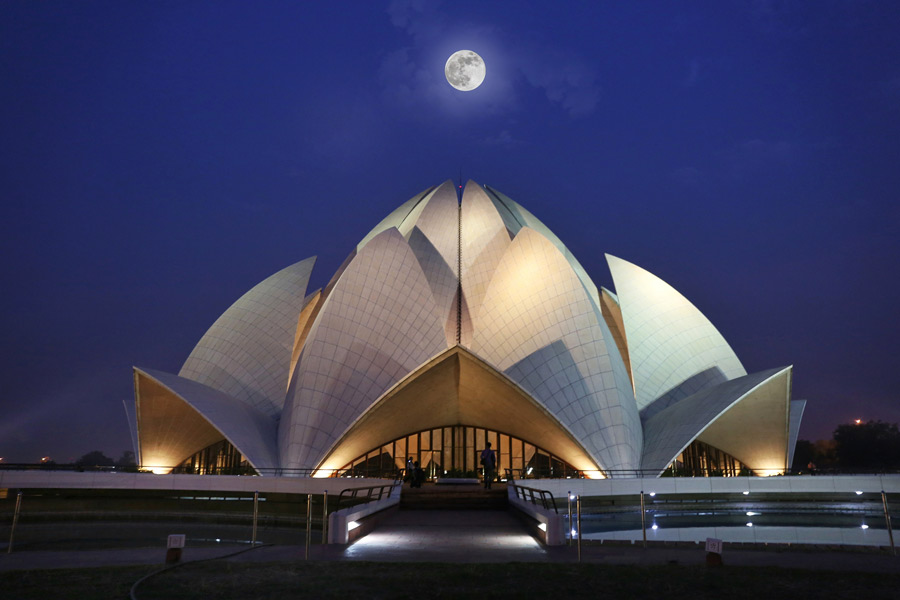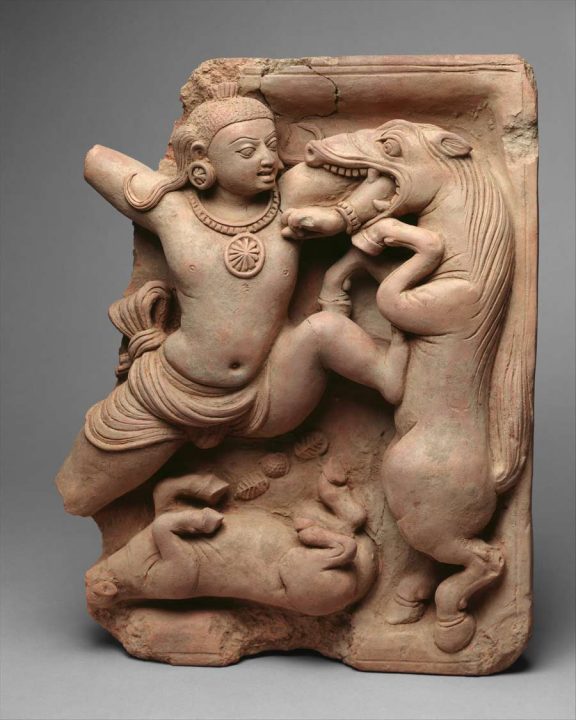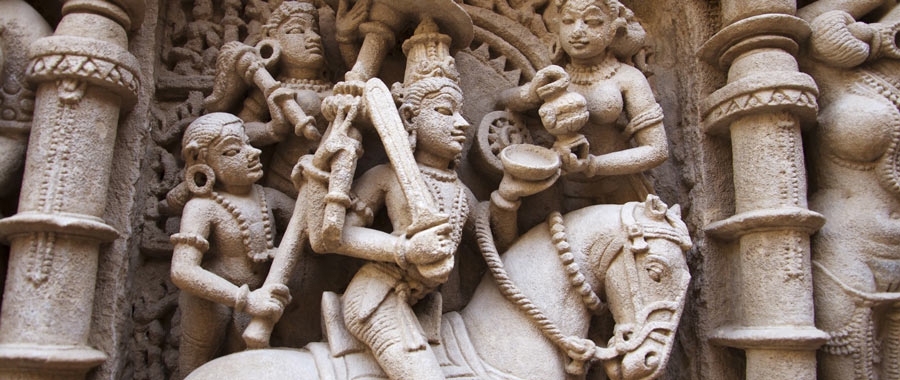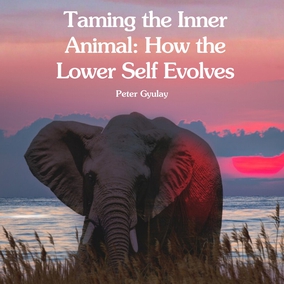The views expressed in our content reflect individual perspectives and do not represent the authoritative views of the Baha'i Faith.
India is currently the country with the largest Baha’i population – an estimated two million Baha’is.
New Delhi is home to the magnificent Baha’i Lotus Temple as well – said to attract more visitors that the famous and glorious Taj Mahal. Although India has a secular government, the world’s largest democracy, India is also a deeply religious nation.

Although India is home to Hindus, Muslims, Sikhs, Jains, Buddhists, Zoroastrians – as well as Baha’is and peoples of other faiths – the single largest religion (or family of religions) is the Hindu Faith. So how have Baha’is in India presented Baha’u’llah, the prophet-founder of the Baha’i Faith, from a traditional Hindu perspective? The answer, in part, is that Baha’u’llah is the return of Krishna as the “Tenth Avatar,” as also indicated by Shoghi Effendi, the Guardian of the Baha’i Faith:
To Him the Bhagavad-Gita of the Hindus had referred as the “Most Great Spirit,” the “Tenth Avatar,” the “Immaculate Manifestation of Krishna.” – Shoghi Effendi, God Passes By
In Hindu tradition, the name of the “Tenth Avatar” is “Kalki” – the subject of several previous articles in this series. Kalki now has his own Facebook page: The Tenth Avatar Of Lord Vishnu – Kalki Avatar
In the Baha’i video, “Sanatana Dharma Renewed” (in English), Kalki is mentioned in connection with Baha’u’llah, as follows (starting at 11:37):
“Hindus also believe in the incarnations of Lord Vishnu. We know that Lord Krishna was the eighth, Buddha is the ninth and Baha’u’llah, we believe, is the tenth incarnation of Lord Vishnu, [the] Kalki avatar. And when [the] Kalki avatar appears, he will recreate the human race, and he will make their minds as pure as crystal.” – Sanatana Dharma Renewed
But there’s a problem: The life, mission and teachings of Baha’u’llah bear little resemblance to the traditional Hindu prophecies regarding Kalki. So what’s going on here? Is Baha’u’llah somehow the long-expected advent of Kalki, despite the details of the Hindu prophecies?
Let’s explore that question from a broader perspective — by examining the problems with complex, detailed prophecies. The apocalyptic narratives about the future advent and adventures of Kalki offer a prime example.
Prophecy is a bridge leading from the past to the future, crossing over the present. Like any preview, prophecy offers a glimpse, not a complete picture, of what’s to come, both as to when and how. This assumes, of course, that a given prophecy is genuine, and is therefore capable of being fulfilled and becoming true.
Prophecies, generally speaking, can be simple or complex. Simple prophecies are typically quite general and straightforward. Here’s an example, where Krishna famously proclaimed:
“For whenever there is a decline in righteousness (dharma) and an increase in un-righteousness, Arjuna, then I emanate myself. For the protection of good people, for the destruction of evil-doers, and for the restoration of righteousness, I take birth in age after age. “– Bhagavad Gita 4.7–8, translated by Richard H. Davis, The Bhagavad Gita: A Biography, p. 24.

Complex prophecies may pose problems, however. Their level of detail can make them somewhat suspect. Questions arise as to their provenance and their origins. How do such detailed purported accounts of the future come to be written? In previous articles in this “Figuring out Prophecy” series, we have offered some examples of such problematic and suspect texts.
For a prophecy to come true, it must be true prophecy to begin with. One way to distinguish between true and false prophecies is the general rule that the simpler the prophecy, the more likely it is to be genuine – and that the more detailed the prophecy, the more likely it is that it may be an apocalyptic narrative, part of what scholars have called “crisis literature,” where the prophecies of last events are somehow related to recently past events, where the outcome projects a kind of “wish image” onto the future.
Examples of after-the-fact complex prophecies are those that have clear sectarian, ethnic and nationalistic features. A prophecy, or complex set of apocalyptic narratives, that describe future wars in detail, including the wholesale slaughter of entire peoples and their religions, with the result that the triumphant religion is restored to the power and prestige that formerly enjoyed, is highly suspect.
From another point of view, prophecies that foretell the restoration and primacy of religion and righteousness following apocalyptic wars are ethically, morally and socially suspect. After all, what is so religious and righteous about war? Why couldn’t a religion gain ascendancy through the power of its positive influence, on its own, without the need to enforce that religion through violence on others? In our day and age, who would want such prophecies to be believed, much less wished for, to even come true? Such prophecies are death wishes, and should be rejected. As such, prophecies need to be critically evaluated. Let me give you one good example.
An extensive Hindu prophecy is the Sri Kalki Purana, available online here. In the Introduction to the the Kalki Purana (abbreviated “KP” for in-text citations) the translator, Bhumipati Das, stated:
“Among the upa-puranas or sub Puranas, the Kalki Purana is most sacred and widely respected. At the end of Kali-yuga, the Supreme Lord, Hari, will incarnate as Lord Kalki and kill all the mlecchas, yavanas, atheists, and Buddhists of the world that defy the Vedic authority. The pastimes of Lord Kalki are the subject matter of this literature, which is presented in story form. Exalted personalities can see everything, past, present, and future. For this reason, there is no fault in narrating these future events as if they had already occurred.”
You can see the real problem here: why would anyone, in their right mind, want God to “incarnate as Lord Kalki and kill all the mlecchas, yavanas, atheists, and Buddhists of the world that defy the Vedic authority”? Why should Buddhists be killed? Or atheists? Or those referred to as “mlecchas” – barbarians, foreigners, or native, “non-Vedic,” non-Hindu, people? Or “yavanas” – Greeks, Romans, Arabs, Persians, or any other group of people who come from West Asia or the eastern Mediterranean?
Not only should we evaluate complex prophecies by use of our moral reasoning, but by historical analysis, when warranted, as an application of the Baha’i principle of the harmony of science and religion. In that light, we can clearly identify the Kalki Purana as a reenactment of a historical episode, projected onto the future.
According to K.P. Jayaswal, Vishṇu-Yaśas was Kalki’s (“Vishnu’s Fame” or the “Glory of God”) was Kalki’s original, honorific title:
“Now who was this great hero? – He was a patriotic and religious Napoleon of India in the late 5th and the early 6th century A.D. No character seems to have left a deeper mark on the latter period of the Purâṇas than he. We know his name: Vishṇu-Yaśas … In view of these data, we can propose with some confidence the identification of Vishṇu-Yaśas with Vishṇu-(Vardhana)-Yaśas (Dharman) of Malvâ. Name. . . . Kalki was probably the original name. . . .”
Same name as to meaning – Baha’u’llah, in Arabic and Persian, means the “Glory of God,” just as Vishṇu-Yaśas, in Sanskrit, also means the “Glory of God” – but entirely different in their respective missions, messages, and means of bringing about individual and social transformation. Suffice it to say that just because a prophecy is promoted as such does not necessarily make it true — or even worthy of serious consideration. If the fulfillment of a prophecy would lead to great injustice and bloodshed, especially for sectarian, ethnic and/or nationalistic reasons, then the nonfulfillment of such a prophecy is preferable, even if the prophecy had any chance at all of coming true. In short, a prophecy about the triumph of good over evil is no good if the way that that victory is achieved is questionable, even on the pretext of a “just” apocalyptic war.
If Baha’u’llah is to be proclaimed, accepted, and embraced as the Hindu Messiah, whether as the return of Krishna or as the appearance of Kalki Vishnuyashas, the fulfillment of Hindu prophecies must transcend the prophecies themselves, and offer a grander vision and better means for such fulfillment.
As to Kalki and the complex prophecies regarding his exploits, as set forth in the Kalki Purana and another texts, Baha’u’llah fulfills Hindu prophecies by transcending their limited vision. In such fulfillment, Baha’u’llah’s teachings and vision for individual and social salvation transcend the prophecies themselves.
So it’s time to cross the bridge of prophecy to the other side, where the destination is prophecy fulfillment, above and beyond whatever was foreseen – or, perhaps, merely wished for – by the prophecies themselves.
Kalki, by all accounts, was little more than a king and a warrior — not a true prophet and not a teacher of wisdom with a vision of social justice, universal values and ethics. Kalki, based on the available texts, had no grand vision, no new paradigm, no new revelation. In fact, Kalki is simply a conqueror, who defeats his enemies, in order to reinstate and restore Hinduism, or at least a medieval form of it, to its former prestige and glory.
As for Baha’u’llah being seen as the return of Krishna, this represents a far more positive truth-claim, and one worthy of serious consideration. The Baha’i teachings include recognition of Krishna, with great respect paid to him:
An Indian said to Abdu’l‑Baha: “My aim in life is to transmit as far as in me lies the message of Krishna to the world.” Abdu’l‑Baha said:
The Message of Krishna is the message of love. All God’s prophets have brought the message of love. None has ever thought that war and hate are good. Everyone agrees in saying that love and kindness are best. – Abdu’l‑Baha, Paris Talks
You May Also Like
Comments

















In the Baha’i video, “Sanatana Dharma Renewed” (in English), Kalki is mentioned in connection with Baha’u’llah, as follows (starting at 11:37):
“Hindus also believe in the incarnations of Lord Vishnu. We know that Lord Krishna was the eighth, Buddha is the ninth and Baha’u’llah, we believe, is the tenth incarnation of Lord Vishnu, [the] Kalki avatar. And when [the] Kalki avatar appears, he will recreate the human ...race, and he will make their minds as pure as crystal.” – Sanatana Dharma Renewed.